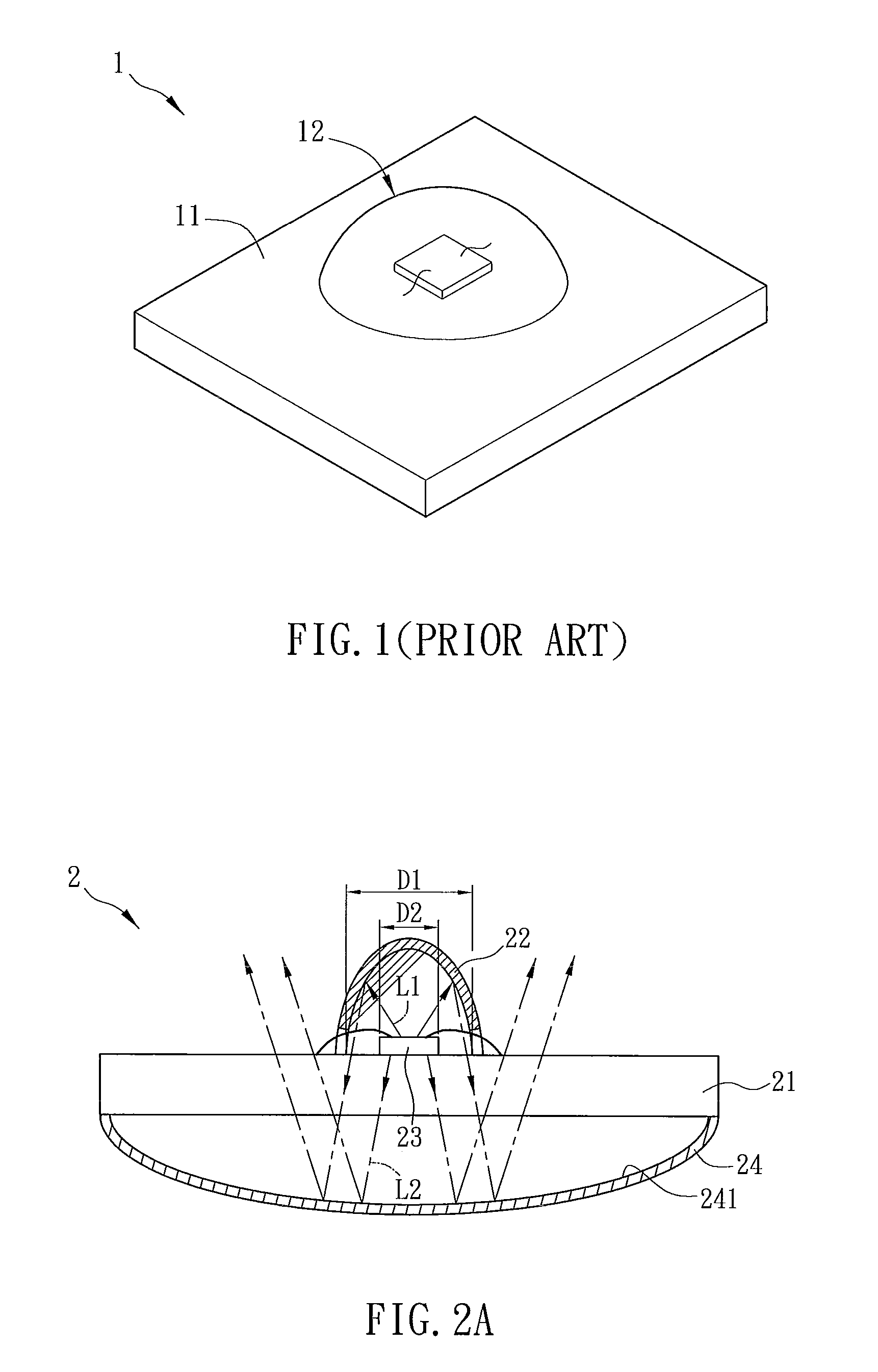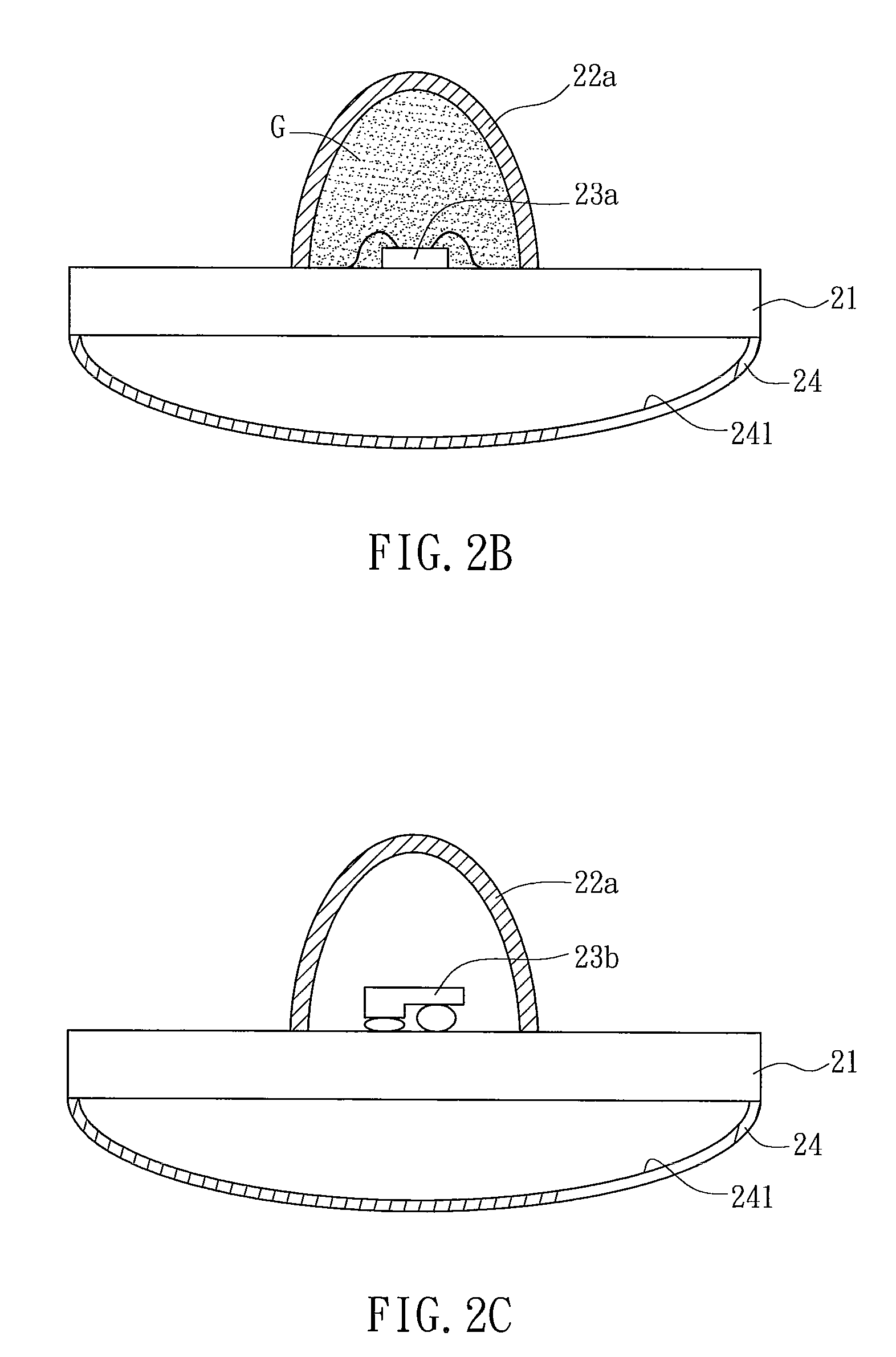Light emitting unit
a technology of light emitting unit and light source, which is applied in the direction of lighting and heating apparatus, semiconductor devices, light sources, etc., can solve the problems of limitation of the utilization of light emitted, and achieve the effect of improving the directional property of light emitted, increasing the light utilization of led, and improving the application field of light emitted
- Summary
- Abstract
- Description
- Claims
- Application Information
AI Technical Summary
Benefits of technology
Problems solved by technology
Method used
Image
Examples
first embodiment
[0024]With reference to FIG. 2A, a light emitting unit 2 according to a first embodiment of the present invention includes a substrate 21, a first reflective element 22, a light-emitting diode (LED) 23, and a second reflective element 24.
[0025]At least one part of the substrate 21 is light permeable, and the material of the substrate 21 may include glass, sapphire, quartz, a polymer material, or a plastic material. In addition, the substrate 21 can be a circuit substrate (e.g. a glass circuit board).
[0026]The first reflective element 22 is, for example, a reflective plate or a reflective cup, and the material thereof can be metal, metal oxide, or white coating. If the first reflective element 22 is a reflective cap, the section thereof can be a planar surface or a curve surface. In this embodiment, the first reflective element 22 is a reflective cap with curved surface, and the curved surface may have one or more focuses. The maximum diameter D1 of the first reflective element 22 is...
second embodiment
[0041]FIG. 4 is a schematic diagram of a light emitting unit 3 according to a second embodiment of the present invention. With reference to FIG. 4, the light emitting unit 3 includes a substrate 31, a first reflective element 32, a LED 33, a second reflective element 34, and a molding body or an insulation layer 36. In this embodiment, the features and functions of the substrate 31, the LED 33 and the second reflective element 34 are the same as those of the substrate 21, the LED 23 and the second reflective element 24 of the first embodiment, so the detailed descriptions thereof will be omitted.
[0042]The molding body or insulation layer 36 at least partially covers the LED 33 and is at least partially disposed between the first reflective element 32 and the LED 33. In this embodiment, the first reflective element 32 is a reflective layer that is formed on the molding body or insulation layer 36.
[0043]If the first reflective element 32 is made of metal, it can be formed by evaporati...
third embodiment
[0049]FIG. 5 is a schematic diagram of a light emitting unit 4 according to a third embodiment of the present invention. With reference to FIG. 5, the light emitting unit 4 includes a substrate 41, a reflective element 42, a LED 43 and a lens element 44. In this embodiment, the features and functions of the substrate 41, the reflective element 42 and the LED 43 are the same as those of the substrate 21, the first reflective element 22 and the LED 23 of the first embodiment, so the detailed descriptions thereof will be omitted.
[0050]The lens element 44 is disposed opposite to the reflective element 42 and is located on a light outputting surface 411 of the substrate 41. In other words, the reflective element 42 and the lens element 44 are disposed on two opposite sides of the substrate 41, respectively. The lens element 44 may be a convex lens, microlens, or Fresnel lens, and the lens element 44 and the substrate 41 can be integrally formed. In this embodiment, the lens element 44 is...
PUM
 Login to View More
Login to View More Abstract
Description
Claims
Application Information
 Login to View More
Login to View More - R&D
- Intellectual Property
- Life Sciences
- Materials
- Tech Scout
- Unparalleled Data Quality
- Higher Quality Content
- 60% Fewer Hallucinations
Browse by: Latest US Patents, China's latest patents, Technical Efficacy Thesaurus, Application Domain, Technology Topic, Popular Technical Reports.
© 2025 PatSnap. All rights reserved.Legal|Privacy policy|Modern Slavery Act Transparency Statement|Sitemap|About US| Contact US: help@patsnap.com



